 Furniture
FurnitureGreat Looking and Comfortable!
Just in case you have a special request, here are some navigational tools
- What is Waterfall, anyway?
- Veneer and Shellac Considerations
- Our Waterfall Bedroom Sets
- Another Collector's Home
- Leslie's Furniture
- The Storytone Piano
- Morrissharp Pencil Sharpener
- Sculptured Pile Art Deco Chairs
- Jigsaw Puzzle Plywood Chair
- Vintage Office Furniture
- Mahogany Hall Mirror
- Thonet Bentwood (Astra and Fischel Labels)
- J and J Kohn Bentwood (Austria, Czechoslovakia and Poland Labels)
- Child's Rocking Chair
- Art Deco Cabinet Singer Sewing Machine
- Restoring a Windsor Rocker
- Restoring a Gate-Leg Table
- Art Deco Torchieres - Howard Chandler Christy Print
- Wright-esque Kitchen Chair
- Potato Chip Chair
- About Charles and Ray Eames
- The Ironrite Health Chair
- The McKay Shoe Store Foot Stool
- Sears Porch Swing
- Wicker Porch Set
- Mode-Craft Furniture
- FDR Lamp
- Douglas Kitchen Master Chairs
- Smoking Stands
- Gilbert Rohde-style Tubular Chair
- Martini Bar
- 1950s Retro Kitchen Conversion for Less than $1000
- Cavalier Cedar Chests (Including Veneer Repair)
- Westinghouse Roasters
- Philco RadioBar Restoration (Including Veneer Repair)
In addition to Furniture, we have a Calendar of Swing Dancing in DC, a Directory of Vintage Clothing Stores and a Guide to 1940s Collectibles. Thanks for tuning in! Feel free to Contact Me if you have questions or want to share photographs and Furniture stories with the rest of the readers.
Waterfall furniture is a catchall term for molded plywood furniture that employs curved or rounded horizontal edges; hence, the term "waterfall". The furniture uses unusual veneer designs and often has clever Bakelite handles.
This was inexpensive furniture in its time. Generally, there is no "frame" -- the molded plywood sides and tops are supported by edge moldings. Often, there are no drawer glides.
The inspiration for waterfall comes from handmade furniture emanating from the modernist movements in France, Austria and Germany. The ultra-exclusive French firm of Sue et Mare is a major source of these "copycat" designs. Early examples mix Victorian motifs with modernist themes and were designed to appeal to broad audiences. Here are some examples of the "Real Stuff" that was imitated by waterfall manufacturers
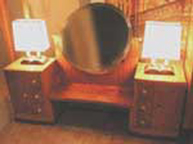
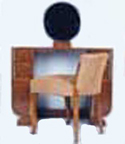
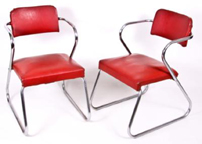
Honest to Gosh Art Deco Furniture in the Large Dollar Range
(left)A Bleached Mahogany Coiffeuse (France, ca. 1925) worth about $12,500
(middle) A Coiffeuse with Chair en Suite by F. G. Saddier (France ca. 1930) Made of Loupe d' Amboyne (a rare wood), fittings of nickeled metal, the chair upholstered in fine suede, worth about $13,500
(right) Pair of Chrome Tube Chairs by Gilbert Rohde, (American, ca 1930) worth about $8,000 each
Click to Enlarge
Note: we call the "Coiffeuse" a "Vanity", the French term is more accurate, meaning a place where a lady might use a large mirror to style her hair.
Using more mundane materials, this style of furniture was mass-produced from the 1920s through the 1940s. Some is absolutely terrible, and a small amount is breathtaking. The style is most frequently seen in Bedroom Suites, although dining sets and even billiard tables were produced. Here is a progression of styles offered in the Sears and Roebuck Catalogues from 1930 to 1939. Things that look like Art Deco are classed as "modern". Note that it is only in 1939 that sears calculated that there would be a mass market for "modern" furniture outside the bedroom.
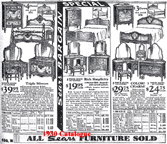
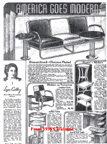
In 1936, "Modern" Makes a Breakthrough
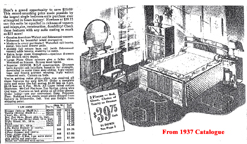
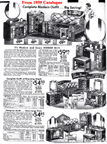
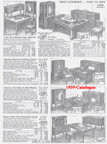
Modern is Acceptable Outside the Bedroom in 1939!
(top row): 1930 and 1936
(bottom row) 1937 and two pages from 1939
Click to Enlarge
The intended market was newlyweds --- during the depression, most new couples could not afford their own house; the best they could do was a room in their parents' house. Hence, the "Bedroom Suite" was probably the only thing that they owned, resulting in inordinate sentimental attachment to the furniture and a reluctance to change even though finances improved. Many couples have kept and preserved their waterfall sets until the very end. As a result many examples of the waterfall genre are available.
The Basic set included a bed, vanity and bench, and chest of drawers. Other items included nightstands, dresser, cedar chest and armoire/chifferobe.
- In 1930 a basic "suite" would have cost from $19.95 to $39.
- In 1936, the "modern" chrome sofa would have cost $49.95 coordinating chairs would have been about $15 each
- In 1937, the basic bedroom set was $39.75 -- and the "modern" version was the price leader.
- In 1939, the "modern" line had complex veneer work and the basic three-piece set sold for $49.95 In addition, a full dining room set (table, 5 chairs, china cabinet and buffet) sold for $103.50
Today, a complete basic bedroom suite goes for $800-$900 in reasonable condition. The hardest pieces to find are nightstands and vanity benches. Cedar chests go for $400 and up. The "value" is sentiment --- on an intrinsic basis, waterfall is not "Fine Furniture" because the construction techniques and materials are generally skimpy. Some labels (Cavalier, Heywood-Wakefield) are exceptions because they used excellent materials.
Technical advances made it possible to mass-produce "waterfall" furniture by adapting the "new" -- for the time -- material plywood. Before plywood was available, curves in wood could only be achieved by laborious and expensive means that were not at all suitable to the assembly line. However, technology embodied in the following patents made it possible to create a large number of attractive pieces at low cost.
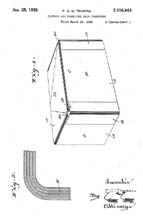
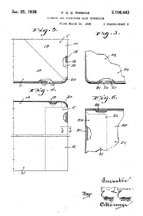
Technology for Bending Plywood into Curves
Waterfall Technology Patent No. 2,106,443
Click to Enlarge
Click Here to learn how to get FREE Patent Drawings
The plywood is covered with veneer or paper-thin slices of real wood, giving the illusion that the piece is made of a more expensive wood, such as mahogany or oak. Veneer has a number of enemies, most significantly moisture that causes the veneer to detach itself from the underlying plywood substrate. The most common veneer damage results from storing the furniture in a humid or damp basement. The veneer loosens at the base of the object and often peels away in a manner resembling "fringe". Heat, particularly cigarette burns can be a problem. If the glue gets too hot it will swell causing bubbles to form. Cigarettes, matches, or other hot objects (i.e. curling irons) can actually destroy the veneer. Our webpage on Restoration of a Radiobar has a number of photos illustrating veneer repair.
The finish is most often mahogany stain and spray shellac with very rare exceptions such as our blonde set shown below. Alcohol is the solvent for both shellac and perfume. Many times, the surface of the vanity is heavily pitted where perfume has been spilled. Our web page on Cavalier Cdar Chests describes several techniques for restoring and reinvigorating the shellac finish. The BIG NO-NO is "Do NOT under ANY CIRCUMSTANCES use paint stripper on a waterfall piece." First, alkaline solutions are NOT the solvent for shellac and Second, the stripper will loosen the glue and the veneer will come off. So, avoid paint strippers.
This is our Waterfall bedroom set. It probably dates from the late 1930s. We are very lucky to have almost all the pieces associated with a set like this -- vanity, dresser, chest of drawers, bed, two nightstands, cedar chest, chair and vanity bench. We do not have an armoire or chifferobe, but we wouln't have a place for it anyway. Some of the pieces are mixed in from other sets (like the Nightstands and the cedar chest), but the feel of the room is much like you might expect for a couple starting out their life. This furniture was very cheap, although the use of veneer effects like bookmatching makes the pieces very attractive. Waterfall has a warmth about it that is not captured by very high end furniture. This stuff will always have a very high emotional value and will remain collectible in the future. It is VERY easy to live with!
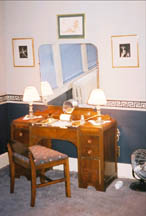
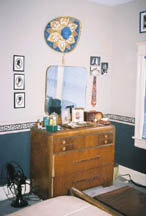
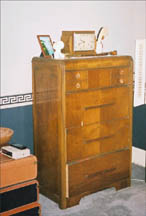
Principal Waterfall Pieces
(left) Vanity (middle) Dresser (right) Chest of Drawers
Click to Enlarge
In the Vanity photo, the flanking photos are X-rays of flowers, very popular in the 1940s. Centered above the mirror is the Vargas Girl from my birth month in the 1940s. The radiant Heater on the floor is on our Fans Page.
In the Dresser photo, on left are silhouettes of my family, cut in Cedar Point, Ohio in about 1950. The Fada Radio on the right is on our Radio Page. The silver-framed pictures are of my Mom and Dad, taken in 1943. The sombrero is intended to evoke American interest in Mexico during the 1940s (an inexpensive desitnation for newlyweds). The "tie" is just that - a 1940s cravat mounted to show off my collection of tie bars. The watches (in globes) are on our Clocks and Watches Page.
In the Chest of Drawers photo, the Sailor Bank is on our Knicknacks Page. The Perivale Clock is on our Clocks and Watches Page. At the top left, rear of the dresser is a "3-D" photo of Niagara Falls, another popular but inexpensive tourist destination in the 1940s.
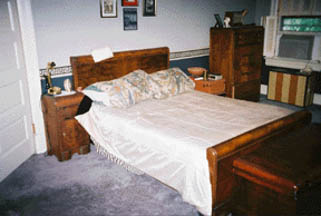
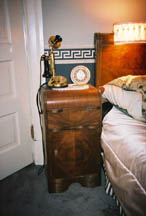
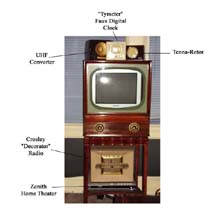
More Waterfall Pieces
(left) Bed (middle) Nightstand (right) Restored "Airline" TV
Click to Enlarge
Here is a Blonde waterfall set that I restored for Karyn's guest room. We toned the finish to coordinate with the wood slat venetian blinds. The handles are all Bakelite. We were very fortunate to get the Vanity Bench!
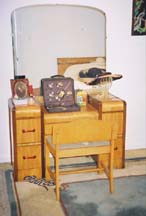
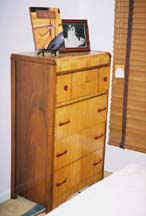
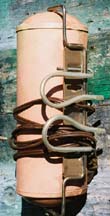
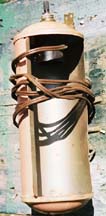
The Blonde Waterfall Set
(left) Vanity (middle) Chest of Drawer (right) Restored Bed Lamp, Befoire & After
Click to Enlarge
Our reader Leslie recently sent us some photos of her collectiron of Waterfall Era furniture. She writes:
"... I came across your site while trying to research Art Deco furniture. I've attached some photos of some of the pieces I've found and rather cheaply! There was a used furniture store nearby which has since closed. He wanted to get rid of all his inventory so I got some great deals! The china cabinet is probably my favorite... I use it as a media cabinet in my living room. I got it for $85 - which I think is a steal! It's in great condition and I love it! The buffet I got for $116 delivered - it's fairly rough, but cleaned up well and all the drawers and doors work perfectly. I got the bedroom vanity (which is in pretty bad shape, but I still love it) for $65, the bed (including foot board,head board, and rails) one nightstand for a total of $45. Dresser 1 is probably the nicest one of my collection. It even has hidden panels in the back for secret storage. I found it on Craig's List for $70. The remaining dresser and nightstand came together for about $100 total (also a Craig's List find). The cedar chest is Roos and was also found on Craig's List for $100. It's in excellent condition and still has the labeling in the lid. The vanity bench was a lucky find on Craig's List also and was $30 - it had already been re-upholstered and appears in about perfect condition for a piece of its age. ! ..."
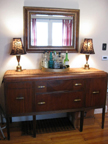
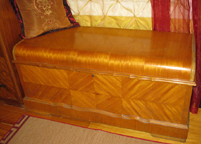

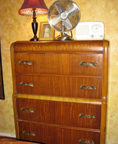
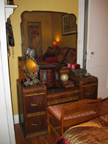
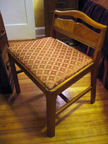
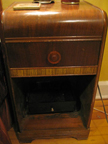

Leslie's Waterfall Furniture
Click to Enlarge
Here is a waterfall chest that was found by our reader Diane. She writes:
"... Do you believe I got this piece from the Salvation Army for only $99? All I had to do was clean it and polish, and just look? I also got the dresser with a round mirror...."
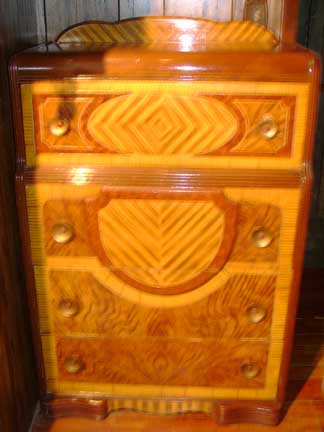
Diane's Waterfall Find
We think that Diane got a very good deal!
Our reader Karen recently sent us photos of a waterfall vanity. She writes:
"... A friend of mine moved suddenly to Hawaii and left this vanity for me to sell. I understand you don't give appraisals but can you tell me a little about this? She said it was made in 1932. She had moved it all across the country and back so finally the original mirror broke. She replaced it as best she could ..."

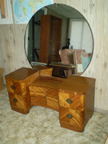

Karen's Waterfall Vanity
Click to Enlarge
This is a very nice waterfall vanity, probably from the mid 1930s. The bookmatch veneer took a lot of skilled labor. Without a close inspection, I can't tell if the exterior is wood veneer or cleverly printed paper. Some manufacturers used this shortcut -- and almost all Philco radios of the 1930s have a paper exterior rather than wood veneer. Paper or wood, there is some damage -- nothing, however that appears to be irreparable. The drawer pulls have a nice design and really add to the piece. It is VERY HARD to find the matching vanity bench, something that would be a real plus for this set.
Or reader Paul sent us some very nice photos of Waterfall and Waterfall-inspired furniture (he has a marvelous collection!):
This is a Mid 1980s Bassett waterfall-inspired bedroom set. Note bookmatched chevrons on door veneer and the Pier Cabinet
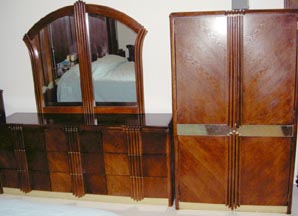
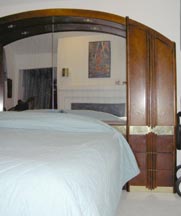
Dresser, Armoire, and Pier Cabinet
Click to enlarge either photo
At the Left is Paul's late 1930s waterfall writing desk (finished front and back for different room configurations) Note the matching electric pencil sharpener and globe In the Center is a 1930s Shanghai sunburst chest with two-tone relief. On the right is the 1936 Encyclopaedia Britannica and it's matching streamlined case with two-tone finish.
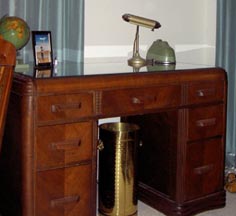
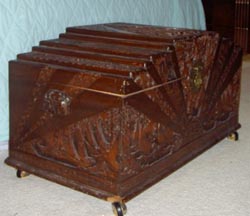
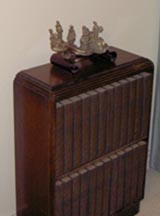
Desk, Chest and Encyclopedia
Click to enlarge any photo
The desk accessories are also of interest. Paul says, "The desk 'set' was never sold as such. What's remarkable about it is that there was such a continuity of style and a consenus about what color turquoise was in the 1940s and 1950s..." The pencil sharpener was designed by Robert Fleming and made in 1947 by the Bert M. Morris Company in Los Angeles, CA. (US Patent 2,408,767) The globe was made a bit later in Italy,
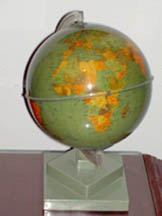
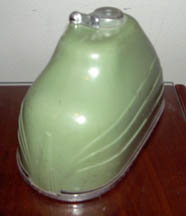
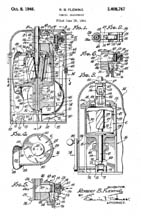
Globe and Pencil Sharpener
Click to enlarge any photo
Click here if you want to learn how to get Free Patent Drawings
Above Paul's desk is a streamlined clock to match the turquoise desk accessories. ( a Telechron "Advisor", model 2H27, introduced in 1949.)
To the left of the desk are Paul's Harps. The Clark Irish Harp is locked into its folding taborette. Beside it is a mid 1870s Erard Gothic Harp (French factory). The Clark was made from 1915 to the late 1940s and was virtually the only harp of its size sold in the United States at the time. It was made by the Melville Clark company until the 1920s, when the Lyon and Healy Company took on the Clark Company's manufacturing. In the late 1930s, Lyon and Healy had too much demand for pedal harps and shifted manufacturing back to Clark. Lyon and Healy lever harps are available with the same soundboard decal to this day. The Clark has a lighter tension and thinner soundboard compared to almost all harps of its size made today. It's very resonant, and its timbre is comparable to an early 20th century pedal harp. Paul says, "It's a joy to play, but it's fragile, which makes it a bit scary to tune. Even a small harp like the Clark has 1,000 lbs of string tension pulling on its soundboard and neck. In the 19th century, pedal harps like the Erard Gothic were as common in people's homes as pianos are today. The Clark would be the most likely newly purchased harp to find its way into the average American home of the 1930s-1940s due to its size and price..."
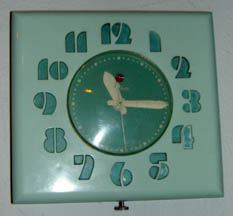
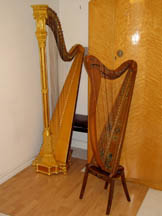
Clock and Harps
Click to enlarge either photo
Entertainment was definitely a subject for Waterfall. On the Left is Paul's late 1940s Streamline Moderne Speaker Cabinet along with a mid 1960s speaker and Edcor stereo-to-mono converter. Check out the Rex-Cole Model 5-A (shown on the speaker) in our Vintage Clocks Page. [NOTE: this was made by the same manufacturer as our Etalage-Reclame clock using a Bakelite base.] The interior of the armoire (right) is a bit more modern. Note the Omnifi digital streamer at top left (for picking up 1930s and 1940s internet radio stations).
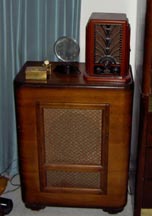
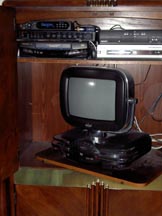
Old and New Entertainment Electronics
Click to enlarge either photo
Here is a picture of the Storytone piano at the 1939 World's Fair as well as a Storytone in Paul's home. This is an extremely rare and historically important instrument. The Storytone piano was built in 1939 in a joint venture between Story and Clark and RCA - the piano has normal strings and action but no soundboard - the sound is amplified by pickups and a speaker system making it the world's first practical electric piano. The sound is very beautiful considering its design during the infancy of amplified instruments. The Storytone Piano was made famous by artist Earl Hines. Check out our Vintage Television Page to see photos of the matching Television (The RCA TRK-9) that went with the Storytone Piano to make the "complete" home entertainment center of the late 1930s.
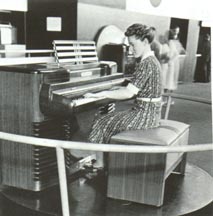
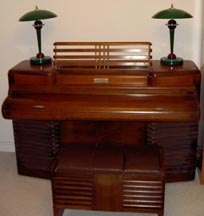
The Storytone Piano at the Fair and in Paul's Living Room
Click to enlarge either photo
Click here to look at another type of collectible, or keep on scrolling for more Furniture.
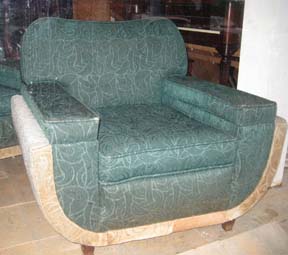
The Green Sculpted Pile Deco Chair
Click on the Photo to Enlarge It
We saw this Deco parlor set in Fells Point in October of 2008. There was a red chair and a sofa in the set as well:
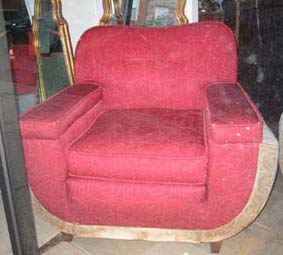
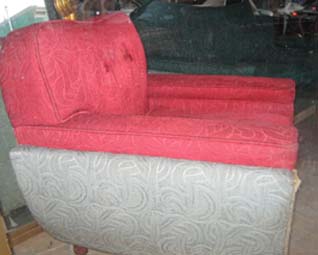
The Red Sculpted Pile Deco Chair
Click on Either Photo to Enlarge It
These were the zenith of the Upholsterer's art, combining shape and texture into a breathtaking whole. Those of you who are into re-covering will note that these chairs have (effectively) an outside back on the bottom. There is a lot of work in these pieces. These chairs are unusually comfortable.
Click here to look at another type of collectible, or keep on scrolling for more Furniture.
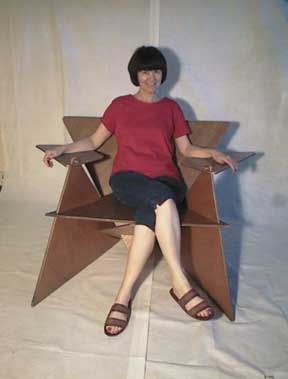
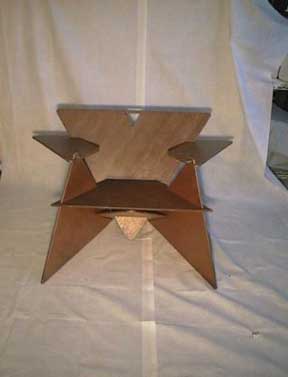
The Jigsaw Puzzle Plywood Chair
These photos were sent to us by our friend Dave in Las Vegas
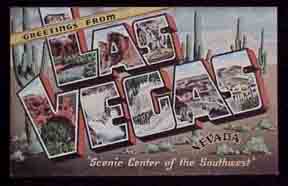
...I ran across a great plywood laminated chair in a garage sale about 15 years ago. It was a chair that was purposely made in about 6 pieces and went together with small round wood dowels...so it could be set up and taken down. It is quite large and to me appears as though it came from the early Art Moderne era. The actual wood dowels are missing and I have only set the chair up about 3 times in all these years because it takes me about that long to figure out how each piece interlocks with the other.You will love this....the garage sale was in a very expensive area of town and when I askled how much for the monster chair..the lady laughed and said she had been literally trying to bribe people to get it out of her garage all morning...So I told her I would give her $5 and she could be rid of it..She very happily said "TAKE IT AWAY"...Last year my wife and I decided to move from Minneapolis to Las Vegas, my wife asked if we had to take the monster since we were getting rid of almost 30 years of collecting and saving...I said we were definitely bringing it with us & we did... During our preparations to move, I set it up in our driveway during a moving garage sale we had (marked not for sale) just to see if anyone out there appreciated this type of furniture....I had one individual that literally begged to buy the chair....
Click Here to see more of Dave's Chair.
MAKE YOUR OWN JIGSAW FURNITURE
Here is a patent diagram of a concept developed by Alfred DeMartini in 1953. It shows how you can manufacture a table and two chairs out of one sheet of plywood!
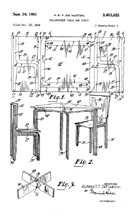
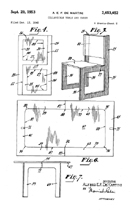
Jigsaw Furniture
A Table and Two Chairs for Less Than $50
DeMartini Jigsaw Table Patent No. 2,653,652
Click to Enlarge
Click here if you want to learn how to get Free Patent Drawings
You can beat IKEA -- all you need is a jigsaw, a drill and one sheet of plywood -- just lay out the pattern shown above, cut and assemble. You might have to do a little sanding and staining, but who's going to complain about a table and two chairs for less than $50 - even less if you use utility plywood and paint it a solid color.
Click here to look at another type of collectible, or keep on scrolling for more Furniture.
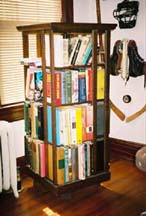
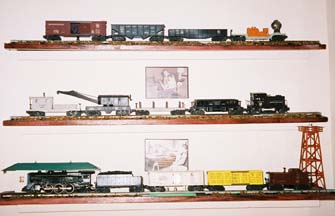
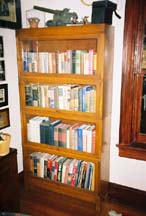
Vintage Office Furniture
(left) Lawyers Rotating Bookcase
(middle) My Lionel Trains from 1947
(right) Globe-Wernicke Sectional Bookcases
Click to Enlarge
Here are some other items from my office.
The first is a "Lawyer's Rotating Bookcase", so named because at one time, it would hold the entire federal Code of Jurisprudence. Needless to say, it is fairly old...
The Lionel Train set was my actual toy in 1947; the pictures show me and my Dad playing with these very same trains
You might be interested to learn that the unusal system of tracks used by Lionel Trains was invented by Mr. Joseph L. Bonanno of Maplewood, New Jersey in 1939. His patent was granted on February 10, 1942. Mr. Bonnano also invented the famous Operating Milk Car that entertained legions of children. (You can watch a video of this fascinating toy on YouTube. Mr. Bonnano received Patent No. 2,664,664 for his pioneering work. Keep that in mind the next time you need a sparkling tidbit to enliven an otherwise dull conversation.
You might want to look at our Streamlined Locomotives Page to see more of our model trains.
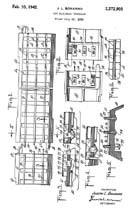
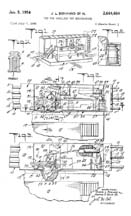
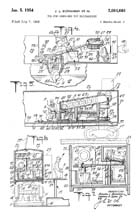
Key Lionel Train Patents
(left) Lionel 3-rail Track Patent No. 2,272,903
(middle, right) Lionel Operating Milk Car Patent No. 2,664,664
Click to Enlarge
I got the Globe-Wernicke sectional bookcases for about $5 each in 1965. They are worth a whole lot more now... These are "Universal 13 inch units", pattern 813 quality 289 1/2. They were made in Cincinnatti, Ohio in the 1920s.
History: An American businessman Henry C. Yeiser set up a furniture factory called The Globe Files Co in Cincinnati in 1882. The factory started manufacturing office and filing furniture. In about the same time, a furniture factory called The Wernicke Co was set up in Grand Rapids, Michigan. A few years later The Wernicke Co designed a bookcase, which consisted of different sized glass cabinet components. By stacking these components on top of and beside one another, you could create different wholes.
Henry C. Yeiser got interested in this design and bought The Wernicke Co factory. With the new owner, the factory was renamed The Globe Wernicke Co. In December 1892 Henry C. Yeiser patented this unique bookcase design. This bookcase design was a huge success and aroused great interest also in Europe. By the end of the 19th century, an English furniture manufacturer Thomas Turner started marketing the design in England. The company was named The Globe Wernicke Co Ltd. In time, The Globe Wernicke Co also expanded to Canada, France, Belgium and Austria.
Click here to look at another type of collectible, or keep on scrolling for more Furniture.
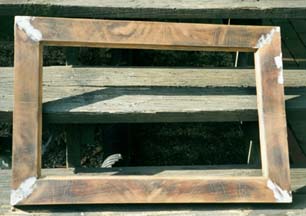
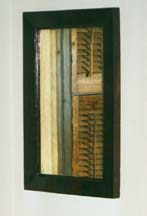
Mahogany Hall Mirror
Before and After
Click to Enlarge
Another Lucky Find: This mahogany mirror was included in the pile with the Gate leg Table and the Rocker. This was a fairly straightforward restoration, although I had to use an epoxy-based wood filler to repair some structural damage. It makes a Wonderful hall mirror.
Click here to look at another type of collectible, or keep on scrolling for more Furniture.
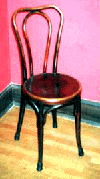
Astra Bentwood
From a Bookie
Posted 11-28-01
This is a Thonet Bentwood chair made in Czechoslovakia and imported by the Astra Bentwood Company. This is the bottom of the line for bentwood chairs. I got five of these for $5 from a bookie in Pittsburgh in 1966. He said "Take as many as you want --- we keep 'em here in case we get raided --- it's nobody's loss" Check out real Astra Bentwoods on e-bay today... The wood is beech that has been steam-bent. The finish is a mixture of lampblack and milk, and it wears to a wonderful aubergne color. Click Here to learn more about Thonet Bentwood Furniture.
Our friend Richard had a similar experience in buying Thonet/Astra bentwood chairs, but the seller was diametrically opposite -- it was the First Presbyterian Church of San Luis Obispo (CA).
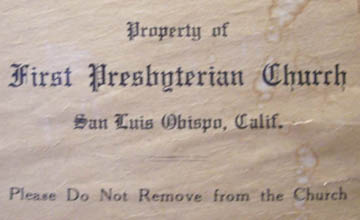
These Chairs Answer to a Higher Calling
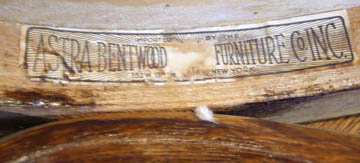
The Astra Bentwood Label
Richard writes: "... These chairs were purchased in the early 1960's. Price $5.00 each. They were Imported by Astra Bentwood Furniture Co., New York. Some of the chairs have the Fischel Tchescoslou stamps on the chairs ..."
The "Czechoslovak State" was an early name for Czechoslovakia, probably during the 1920s. Czechoslovakia was founded in October 1918 as one of the successor states of Austria-Hungary at the end of World War I. It consisted of the present-day territories of the Czech Republic, Slovakia and Carpathian Ruthenia. Its territory included some of the most industrialized regions of the former Austria-Hungary and is a logical origin for mass-produced furniture.
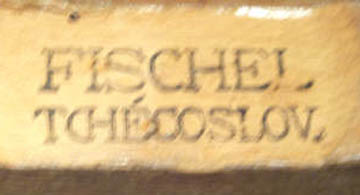
The Woodburned (Brand) of the Fischel Company
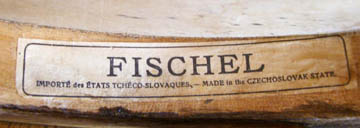
The Fischel Bentwood Label
The company was founded by David Gabriel Fischel one month after the “patent” granted to Thonet expired. Fischel, a vegetable oil salesman from Prague, opened his business on June 10 1871 and placed it in the hands of his eldest son Alexander Fischel who had worked for Thonet for many years at their Koritschan factory. At Niemes, a smalltown in the most industrial part of the Danube region, the Fischel factory employed 100 workers and produced 100 units per day. According to the Thonet Website, the label on Richard's chairs dates to the 1920s.
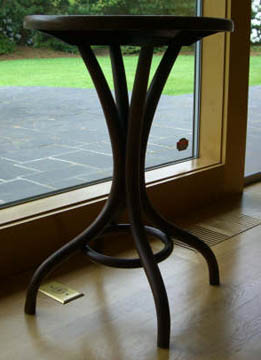
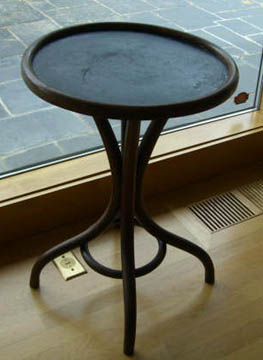
Richard's Thonet Table
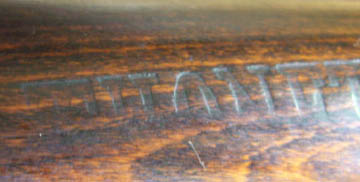
The Thonet Woodburned Brand
Richard also has this to say about his lovely Thonet table: "... We purchased the table in McMinnville, Oregon $75.00 great price. (ed: NO Kidding!!) It has the Thonet stamp on one of the legs. It is 27 inch high and 18 1/4 inch dia. ..."
Click here to look at another type of collectible, or keep on scrolling for more Furniture.
J and J Kohn Bentwood Chairs
J&J Kohn were among the first mass marketers of bentwood chairs. "Semper Sursum" means [literally] "Always Upward" or [figuratively] "Aim High" The Kohns made furniture in Austria (rare), Czechoslovakia (available), and Poland (common). Here is how to tell the difference:- Austria: Look for J & J Kohn, Wien [Vienna] followed by "regisgtrite Schutzmarke" [Trade Mark]
- Czechoslovakia: J & J Kohn, "MUNDUS"
- Poland: Look for the abbreviation "ZBM" ["Zaklady Przemyslu Meblowego"] means "Furniture Industry Plant Mazowia". Mazowia is a county/province in Poland and the town is Radomsko, the capitol of the Polish Wood Industry. Beautiful furniture is still being made there.
Our friend Richard sent us some photos of some J & J Kohn chairs that he had found, and we believe that he has some of the very nice Austrian chairs.

The Label for Chairs made in Austria
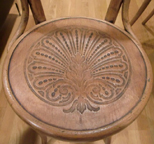


Richard's J & J Kohn Vienna Bentwood Chairs
Authenticate the label carefully!
Click to Enlarge
Unfortunately, in these days of Photoshop and high-resolution scanners, antique dealers have been known to counterfeit labels to upgrade mass-market pieces to higher grade. Check the label carefully. Even though the Company and trademark may have been in Vienna ("Wien") the chairs could have been cranked out in Poland. Look for the ZBM woodburned some place on thepiece. Also, the Thonet company purchased these chairs and imported them into the USA, so it is also possible to see Thonet labels in conjunction with the various J & J Kohn labels.
Click here to look at another type of collectible, or keep on scrolling for more Furniture.
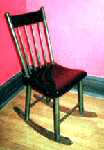
Child's Rocking Chair
Came with the house...
Posted 11-28-01
This child's rocking chair came with my house when I bought it in 1974. The chair sat in the basement for years. It was really a basket case. I got sick of looking at it, so I took it completely apart and restored it. It's real nice if someone brings a kid over...
Click here to look at another type of collectible, or keep on scrolling for more Furniture.
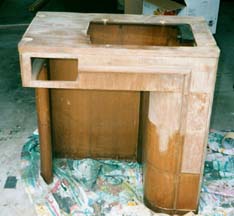
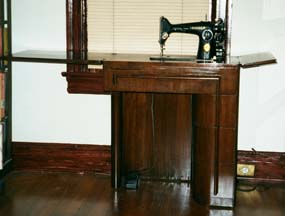
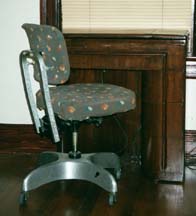
Singer Sewing Machine in Art Deco Cabinet
(left) During Restoration (middle) Open, Showing Machine (right) Closed
Click to Enlarge
Posted July 25, 2001
Art Deco Sewing Machine Cabinet
On a trip to Brunswick, Maryland, we found this Singer sewing machine. The interesting thing is that it has an Art Deco inspired case. I paid $39 for it --- and it included all the Singer accessories, including the Buttonholer and the Curtain Pleater. As is generally the case, the Singer machine still works perfectly. In the 1930s and 1940s, the Singer company made things that lasted forever!
This is the only Singer sewing cabinet that was made in the Art deco style. Here is the design patent for this machine
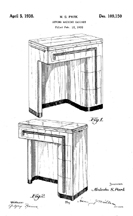
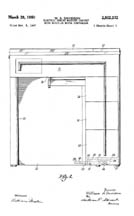

Art Deco Sewing Machine Case
M.S. Park Design Patent D - 109,150
W.A. Davidson for the Singer Corporation, Patent No. 2,502,372
Advertisement for the Deco Singer Sewing Machine
See our Fans Page for details on the Ribbonaire Fan in the ad
Click to Enlarge
Click here if you want to learn how to get Free Patent Drawings
The case is mahogany veneer with a shellac finish; it showed marks of lots of abuse. Round water stains indicated that leaky flower pots had made their home atop the case, and the finish had been dulled by mildew probably from storage in a damp basement. As you must know by now, all of this is very easily fixed. The shellac was lightly sanded and re-amalgamated by lots of rubbing with alcohol. (Alcohol is the solvent for shellac...) This process removed almost all the scratches and built up a very nice finish. Spar varnish was used to protect the surface
The second photo shows the machine ready for use, with the fold-out work surfaces extended. Several clever spring arrangements bring out arms to support the extensions and the machine itself is ingeniously counterweighted.
The third photo shows the case with the machine and work surfaces stored. This can double as a very stylish writing or reading desk. In 1995, I restored the EMECO aluminum secretarial chair. I guess that it has been waiting all these years to be paired with the sewing machine...
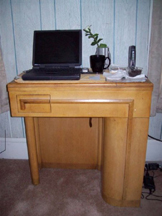
Our Reader's Blonde Deco Singer Sewing Machine
Click to Enlarge
We want to thank our reader Gunther for sending in this photo.
Click here to look at another type of collectible, or keep on scrolling for more Furniture.
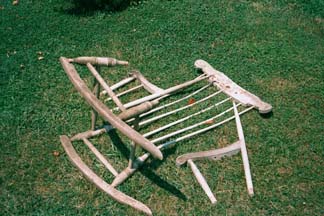
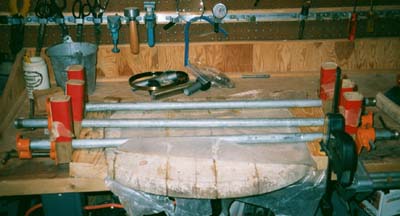
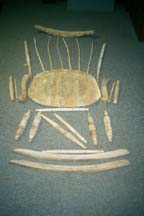
The Windsor Rocker, Carpentry Phase
(left) As Found (middle) Repairing the Seat (right) Parts Repaired, ready for Finish
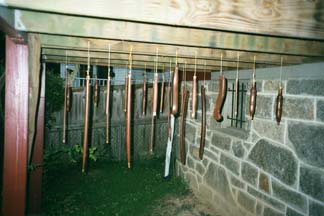
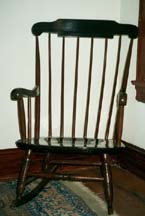
Windsor Rocker, Staining and Completion
(left) Staining the Pieces (looks like "salami", huh?)
(right) The Final Product
Click to Enlarge
Posted July 25, 2001
Windsor-Style Rocker
I take "before" pictures because a lot of people just can't comprehend that so much good stuff is just lying there for free on Bulk Trash Day. Well, there are Bulk Trash days and then there are BULK TRASH days. One morning in May, 2001, I hit the jackpot! This Windsor-style rocker, the Gate Leg Table and the Hall Mirror were all found at the same time. Repeat --- they were all free.
As you can see in the first picture, the Rocker was barely recognizable. It had broken into four "chunks" and was rather unceremoniously dumped on the ground. An examination showed that ther pieces were all there, but that the seat had come apart. I loaded the remains into the car and hoped for the best
The seat is the most important part of a Windsor-style chair, because all the other parts fit into it. In a true Windsor-style chair, the seat is formed from one large block of wood. In this case, it would require a single slab of oak about two feet square and three inches thick. (a VERY expensive prospect) The factory that manufactured this chair (my guess is that it dates from the 1920s) made a laminated seat by gluing together a dozen small strips of oak; this size stock that is much more available and economic. The factory used a tongue and groove joint, and held the strips together with a casein type glue, most likely made from animal hides.
The entire chair was covered with thin mud. It looked like the chair had been left outdoors for some time, probably on a porch or patio somewhere. It looks like water had swelled the wood, opening the seams on the laminated seat. Eventually, the glue deteriorated aaaand the components of the seat fell apart, taking with them parts of the chair. However, all 12 parts were right there with their tongues and grooves intact. All I had to do was remove the glue residue, apply a much stronger epoxy glue, and clamp the assembly back together. For safety sake, I bored four 1/4 inch holes through the entire width of the chair and inserted dowels. The second photo shows the process of putting the seat back together.
The chair had been painted white at some time, probably as part of somebody's "brightening" campaign back when magazines like Good Housekeeping urged women to "brighten up Grannie's old rocker by painiting it dazzling white" (or some such nonsense). Needless to say, it was impossible to salvage the old finish, so I got out the heat gun and took the thing down to bare wood. An epoxy-based wood filler was used to repair damages and fill the seams. The pieces were sanded with three grades of paper, 60, 100, and 150. The wood was carefully cleaned with naphtha, a petroleum derivative that removes grease but won't raise the grain.
The third picture shows the pieces after all this work
The fourth picture shows the various pieces being stained. Actually, several things went on. First, a thin coat of shellac was applied to seal the wood. Then, several coats of water-borne gel stain (Rosewood) were applied. Then, the pieces were sanded with 200 grit paper and a thin coat of shellac (alcohol solvent) was applied over the stain to serve as an inter-face between the stain and the glaze coats, keeping one from dissolving into the other. For this piece, the "glaze" was clear water-borne urethane with several drops of pigment added; red, yellow, and brown glaze coats were added and each glaze coat was wet-sanded. Four coats of clear urethane completed the finishing --- the first two were wet-sanded with synthetic steel wool, the third was rubbed with #0000 steel wool and the final coat was treated with Auto Rubbing Compound.
The finished product is shown in the last picture. It is a very comfortable addition to my office.
Click here to look at another type of collectible, or keep on scrolling for more Furniture.
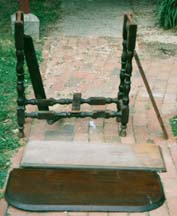
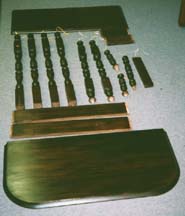
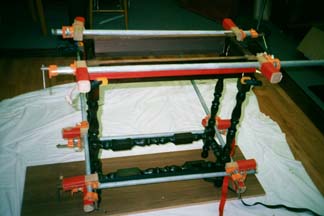
The Gate leg Table, Carpentry Phase
(left) As Found (middle) Inventory of Pieces (right) Regluing the Table Structure
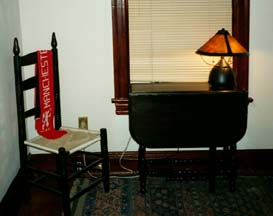
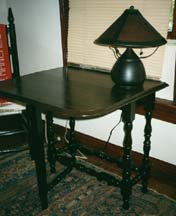
The Completed Gate Leg Table
(left) Closed (right) Open
Click to Enlarge
Posted July 25, 2001
Gate Leg Table
This is a vey nice dark mahogany gate leg table. As found, there were several problems. First, one of the two leaves was missing as was the actual gate leg. Next, there was an enormous round stain on the center, indicating that a leaky flower pot had probably resided there. On the other hand,the thing was solid mahogany and seemed eminently restorable.
Once again, the glue in the joints had deteriorated and the entire structure was quite rickety. Thus, it was necessary to disassemble the table into its component pieces. The center panel and leaf had incurred considerable damage, so they had to be reduced to bare wood. The table frame was in much better shape and needed only a light sanding.
Because this was solid mahogany, I opted for a completely "organic" finish. The surfaces were sanded with increasingly finer grits --- 60, 100, 150, 200. A thin coat of shellac was applied. Alternating coats of penetrating stain and shellac were applied to build up a depth of finish. The stain is soluble in mineral spirits while the shellac is soluble in alcohol. This layering process simulates the growth of trees and gives a very rich finish without unduly hiding the grain of the wood. A total of six layers were required to disguise the residue of the flower-pot stain
The table was glazed with spar varnish mixed with pigment (Iron Oxide and Van Dyke Brown, in separate coats). Each glazing was allowed to dry for a week and wet-sanded. A final clear coat was applied and buffed with #0000 synthetic steel wool and auto rubbing compound. Yes, the table required about two months of wall time to complete, although each individual work session was only about half an hour.
I had to fabricate a Gate leg --- a piece of mahogany from my "remnants" pile was pressed into service, proving that it is valuable to scavenge wood furniture even when it cannot be restored.
The last photo shows the table in service in my office. The table now holds a Bean Pot lamp with a mica shade that I picked up at a church thrift store for a few bucks. It required only minor re-wiring.
Click here to look at another type of collectible, or keep on scrolling for more Furniture.
Click here to look at another type of collectible, or keep on scrolling for more Furniture.
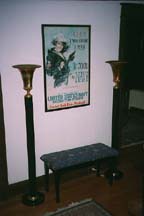
The Torchieres
and Other Assorted Goodies
Click to Enlarge
I bought this spectacular pair of Art Deco Torchieres from a funeral home in Pittsburgh. They used to be set at each foot of the coffin. They initially had Magnum sockets which meant that they used enormous high heat bulbs. After rewiring them, I had them in my office for years --- although they were borrowed on several occasions for use in the National Symphony Decorator Showcase Houses. Well, I'm not the only one with unusual taste...
The recruiting poster ("Gee! I wish I were a man..") by Howard Chandler Christy is an original. My mother's father took it down on the day World War I ended. He kept it and left it for me. I have always admired the young lady's use of the subjunctive.
That's a Steinway piano bench that someone threw away. I recovered it on Bulk Trash day. I refinished the base, but the top was too far gone. So, I upholstered it with a wonderful Deco print fabric that was on sale at G Street Remnants
Click here to look at another type of collectible, or keep on scrolling for more Furniture.
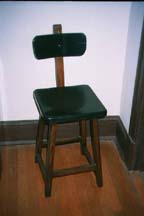
Kitchen Chair
...with "Wright-esque" Overtones
Click to Enlarge
I bought this kitchen chair in Frederick, Maryland for about $5. It was painted red and white. When I got it down to the bare wood, it appeared that this was the original color scheme. This has lines that remind me of stuff by Frank Lloyd Wright. I don't have any more provenance, but I really like it!
Click here to look at another type of collectible, or keep on scrolling for more Furniture.
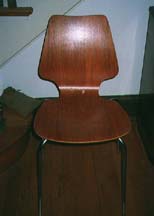
Potato Chip Chair
...Eames Modular Furniture
Click to Enlarge
Charles and Ray Eames
A chair that looked like a potato chip. Another that resembled a "well-used first baseman's mitt." A folding screen that rippled... With a grand sense of adventure, Charles and Ray Eames turned their curiosity and boundless enthusiasm into creations that established them as a truly great husband-and-wife design team. Their unique synergy led to a whole new look in furniture. Lean and modern. Playful and functional. Sleek, sophisticated, and beautifully simple. That was and is the "Eames look." That look and their relationship with Herman Miller started with molded plywood chairs in the late 1940s and includes the world-renowned Eames lounge chair, now in the permanent collection of the Museum of Modern Art in New York.
Charles and Ray achieved their monumental success by approaching each project the same way: Does it interest and intrigue us? Can we make it better? Will we have "serious fun" doing it? They loved their work, which was a combination of art and science, design and architecture, process and product, style and function.
"The details are not details," said Charles. "They make the product." A problem-solver who encouraged experimentation among his staff, Charles once said his dream was "to have people working on useless projects. These have the germ of new concepts." Their own concepts evolved over time, not overnight. As Charles noted about the development of the molded plywood chair, "Yes, it was a flash of inspiration," he said, "a kind of 30-year flash." In fact, Eames wor in molded plywood had rather humble origins -- during World War II, he made molded plywood leg splints, as shown below. This, in turn led to his famous "Potato Chip Chairs", patented somewhat later.
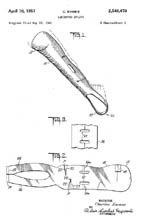
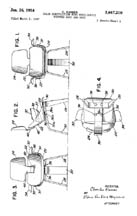
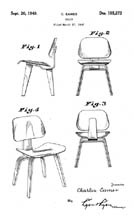
Eames Molded Plywood Patents
(left) Molded Plywood Leg Splint Patent No 2,548,470
(middle, right) Eames Potato Chip Chair, Design Patent D-155,272 and Technical Patent No 2,667,210
Click to Enlarge
By the way,at the same time, Marcel Breuer was also experimenting with molded plywood, as shown in these patent diagrams:
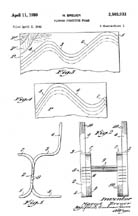
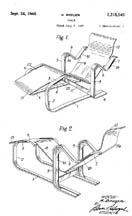
Breuer Molded Plywood Patents
(left) Molded Plywood Chair Patent No. 2,503,933
(right) Molded Plywood Chaise Patent No 2,215,540
Click to Enlarge
For the Eames, one thing always seemed to lead to another. Their revolutionary work in molded plywood led to their breakthrough work in molded fiberglass seating, as illustrated below:
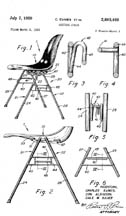

Eames Molded Fiberglass Patents
(left) Molded Fiberglass Nesting Chair Design Patent No. 2,893,469
(middle, right) Molded Fiberglass Multiple Chair Patent No 2,812,800
Click to Enlarge
A magazine contest led to their highly innovative "Case Study" house. Their love of photography led to film making, including a huge seven-screen presentation at the Moscow World's Fair in 1959, in a dome designed by their friend and colleague, Buckminster Fuller. Graphic design led to showroom design, toy collecting to toy inventing. And a wooden plank contraption, rigged up by their friend, director Billy Wilder for taking naps, led to their acclaimed chaise design. A design critic once said that this extraordinary couple "just wanted to make the world a better place." That they did. They also made it a lot more interesting.
Click here to look at another type of collectible, or keep on scrolling for more Furniture.
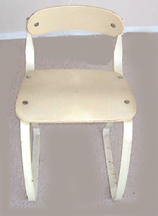
Ironrite Health Chair
Click on the Photo to Enlarge It
We have a special page all about Ironing and a considerable part of it is devoted to the Ironrite ironing machine, mainly because I have one and use it all the time. The following is about the chair that was sold as an optional accessory to the machine. Lately, they have become somewhat popular as general seating as well as specific seating before the ironer.
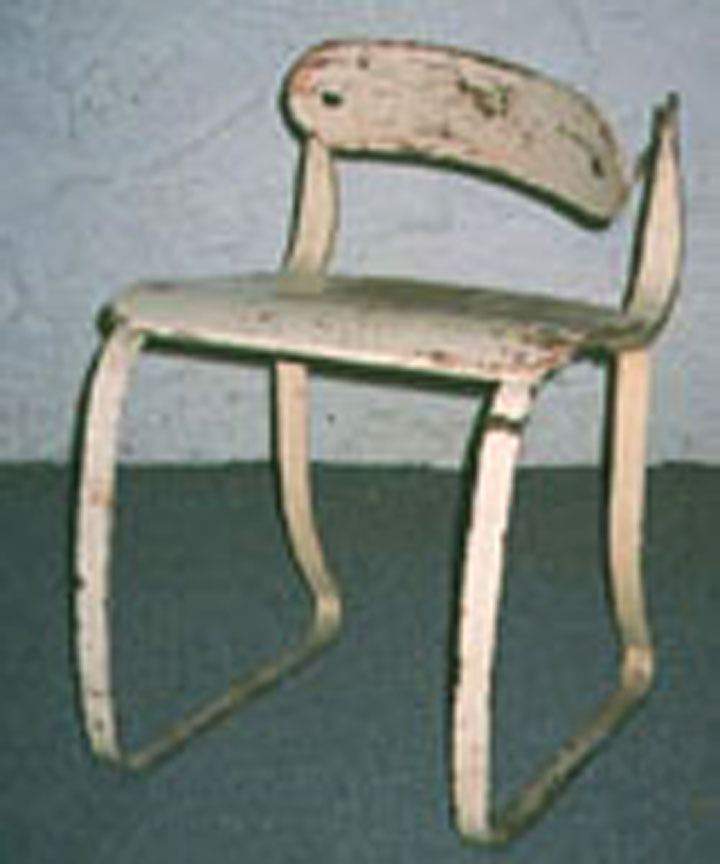
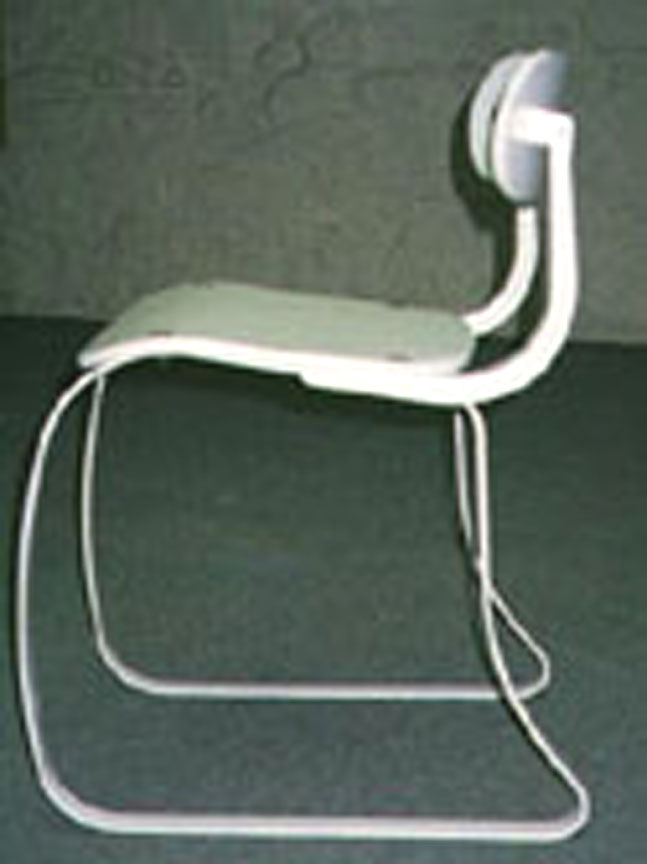
The IronRite Health Chair, Before and After
An Absolutely lucky find...
About a month after I found the IronRite machine, I was at an estate sale in Bethesda. Off in the corner was a beat-up molded plywood chair. Upon examination, I was STUNNED to find that this was an IronRite Health Chair, the official chair that goes with my machine. Not only that, it is the appropriate chair for the Model 85! (The later model [95] featured a chair with a reinforcing splat between the legs...) As you can see, a considerable amount of work was required to get this back in shape. Lord knows what the odds against repeating this feat are.. Well, good things come to those who search.
The Health Chair should have the authentic Ironrite Decal on the back. Here is a closeup of what it looks like. Unfortunately, the decal is placed right in the center of the back, right where you would hold the chair; in many cases the decal is worn away
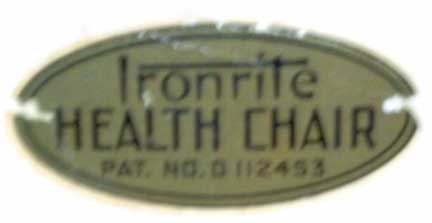
The Official decal from the Ironrite Health Chair
Like everything else about the Ironrite, the Health Chair was invented by Mr. Herman Sperlich, founder, CEO and chief cook & bottle washer for the Ironrite Company. Here is his design patent for the chair, issued in December of 1938, and for reasons discussed below, it is shown next to the patent for a "spring steel chair" developed by Famous Artist Marcel Breuer
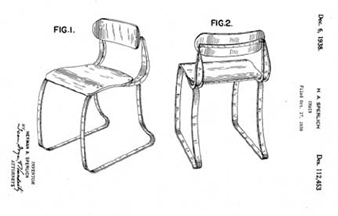
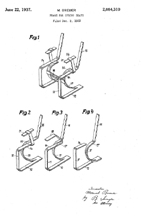
Spring Chair Designs
Ironrite Health Chair Patent D-112,453
Marcel Breuer Spring Chair Patent No. 2,084,310
It looks like Breuer beat Mr. Sperlich by at least a year...
Click to Enlarge It
Click here if you want to learn how to get Free Patent Drawings
Here is an ad in which a Mrs. Belmont Morgan (sounds ritzy, doesn't it...) got rid of her backache by using the Ironrite and its Health Chair. It probably gave her more time for tennis...
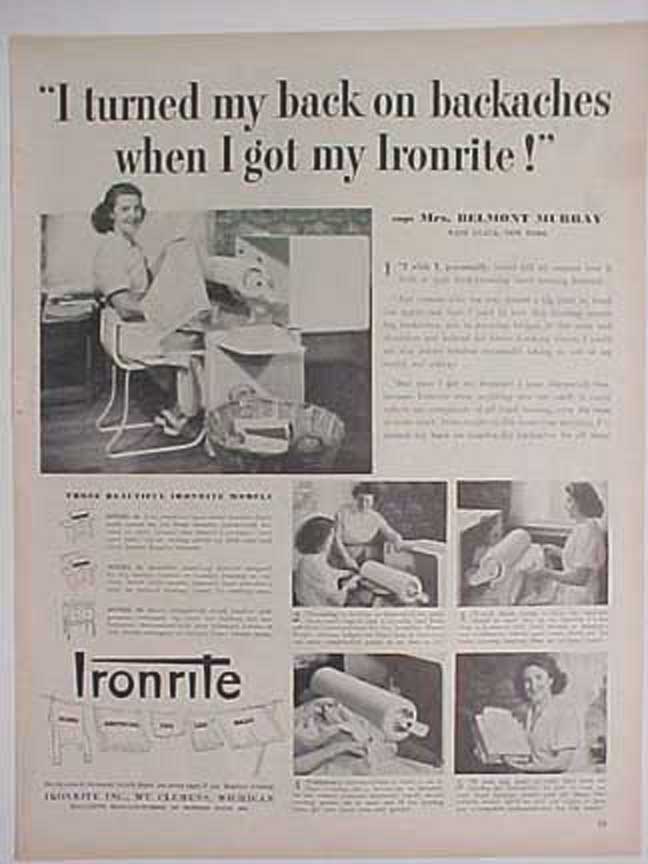
Ironrite Ad from 1952
Note that the lovely Mrs. Morgan is using a Model 85 Health Chair
FRAUD WARNING
Recently, the onlline auctions have been offering the Ironrite Health Chair as if it were an art object! One ad offered an "Authentic Herman Sperlich Health Chair" and wanted something like $500 for it. I think that the intention was to confuse you with Herman Miller a company that actually does make art furniture. One online auction was particularly outrageous when it linked the name of the inventive, dog-loving Mr. Sperlich with that of Marcel Breuer who has been described variously as a "genius" or a "crank":

Marcel Breuer
One of the Founders of the Internationalist Style
I really don't want to get into a discussion of the merits of the International Style other than the fact that it was developed by Communists in pre-WWII Germany but became the dominant genre for 1960s Corporate America. The Wassily Chair (below) was found ubiquitously in the lobby of PanAm, AT&T and other behemoths that have long been extinct. I think that the appeal of this chair for lobbies is that it is uncomfortable and you can't sit in it for very long. I have no idea how this is derived from Marxist doctrine other than a clever very-long-range Bolshie Plot to make Capitalists uncomfortable...
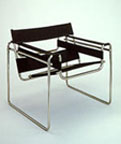
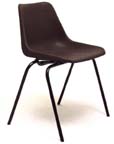
(l.) The Wassilly Chair (r.) The Robin Day Polyprop Chair
You can't sit in either for very long!
The Ironrite Health Chair is actually quite comfortable. However, it isn't "high art" and it isn't worth a whole lot of money. Mr. Sperlich was a brilliant engineer, but he is just a normal guy as far as "art" is concerned. And, as you can see above, Mr. Breuer beat Mr. Sperlich to the punch by at least a year...
Click here to look at another type of collectible, or keep on scrolling for more Furniture.
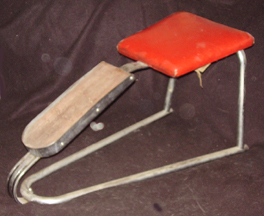
McKay Shoe Store Foot Stool
Click on the Photo to Enlarge It
This is a shoe salesman's foot stool that I found in Canonsburg, Pa, just south of Pittsburgh. It is interesting in its own right, but it is also part of a wonderful line of chrome-steel furniture that was manufactured by the McKay Company in Pittsburgh. This company is becoming much more collectible, although it is hard to find pieces because output was relatively small and more-or-less limited to the Western Pennsylvania area.
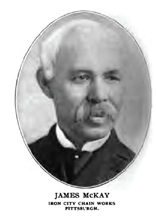
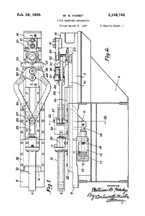
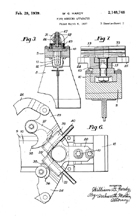
James McKay, Oil Man, Miner, and Metal Bender
W.G. Hardy for the McKay Company, Pipe Bending Device, Patent No. 2,148,748 Click on Either Photo to Enlarge It
Click here if you want to learn how to get Free Patent Drawings
James McKay was born in Ireland in 1830 and emigrated to the United States in 1848. He began as a wholesale grocer, but became became identified with the oil industry during the boom of 1876 in Butler county. He owned "Jenkins Oil Field" that produced about three thousand barrels per day. Looking westward, he purchased the "Yankee Girl Silver Mine". This was one of the largest mines in Colorado. In 1887, he organized firm of James McKay & Company, taking into partnership his two sons, Robert J. and J. Albert. Among the enterprises conducted by the McKays was the Iron City Chain Company that fabricated a wide variety of products made by bending metal.
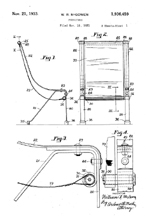
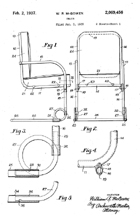
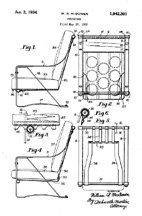
William R. Mcgowen, Furniture Designer
W.R. Mcgowen for the McKay Company, Patent 1,936,459, 1,942,301,2,069,456
Click to Enlarge It
Click here if you want to learn how to get Free Patent Drawings
As discussed above, Marcel Breuer was among the first to create furniture from bent tubular metal in the 1930s. As the fashion for this type of furniture advanced in the 1930s, William R. Mcgowen joined the McKays as a designer and produced a number of tubular and spring-metal chairs, stools, divans, etc. Some of his patents antedate those of Breuer. The firm continued to manufacture small quantities of commercial furniture (such as the shoe store stool) and was eventually sold in the 1960s to Teledyne Corporation.
Click here to look at another type of collectible, or keep on scrolling for more Furniture.
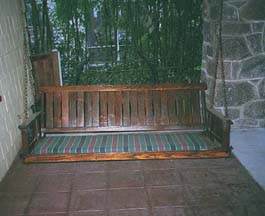
Porch Swing
...From the Sears Catalogue
Click to Enlarge
I found this "Missionesque" porch swing at a yard sale. Tucked up underneath the thing was the original invoice from the Sears catalogue for 1946. I spent some time carefully refinishing it and now it is a wonderful addition to my front porch.
Click here to look at another type of collectible, or keep on scrolling for more Furniture.
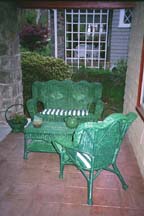
Wicker Porch Set
...From Dixon's
Click to Enlarge
I bought this wicker set at Dixon's auction gallery in Crumpton, Maryland. The three major pieces were sold as a lot and went for $20 --- I had to do some repairs and refinishing, of course. It turns out that a hot glue gun works wonders in repairing wicker. For my money, hunter green is the ONLY color for wicker.
The two flower holders were originally gift baskes from Harry and David's (in Medford Oregon). Has anyone seen the film Double Indemnity? Does the phrase "Medford, Orgeon" ring a bell?
Click here to look at another type of collectible, or keep on scrolling for more Furniture.
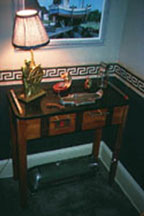
Manicurist Table
Click to enlarge..
Another Lucky Find: In July, 1999 I was having my car serviced at the Sunoco on Connecticut Avenue near what used to be Chevy Chase Lake (approx. Connecticut and Jones Mill Rd). During the 1920s, the Connecticut Avenue trolley line ended here and the Chevy Chase Land Company built a recreational facility on a "lake" made by damming up Rock Creek. So, people would take the trolley to come swimming in the far rural outreaches of the city... Boy have things changed!
OK, while the car was being serviced, I dropped into the Crestar (...now Sun Trust...) Bank branch to use the ATM. This particular building is a survivor of the old Perpetual Savings and Loan, the ONLY financial institution in DC that did not shut down in the Banking Crisis of 1932. (Perpetual, however, did succumb to the Thrift Scandal of the early 1980s.) On the other hand, they left behind this building, a masterpiece of 1950s international style architecture. If you like this period, you should pay a visit before the number crunchers turn this into a Starbucks. This harkens back to a time when you might actually think of getting dressed up to go to the bank. Boy, that really was 50 years ago... Nowadays, you have to think about washing your hands after you go into most banks.
After paying attention to the murals, carpets, lighting and Scandinavian wood furniture, I made my way back to the Sunoco station. On the way, I noted a small table on the street, looking very much like a candidate for bulk trash day. I spent some time finding a worker who spoke English, but eventually determined that the object was, indeed slated for disposal. I picked the thing up and carried it back to the car.
I have NO idea how this got into a bank, but it is an actual Modecraft manicurist's table. The black top is an early laminate, and the aluminum handgrips on the top are set in Bakelite. The handles on the two drawers were originally Bakelite, but I was only able to find one of them, and so more contemporary brass and chrome handles have been substituted. One of the two drawers has a glass front with a red cross and the word "Sterilizer". (This is just a drawer and shows no sign of ever having been anything else.) here's the Design patent Drawing or this table.
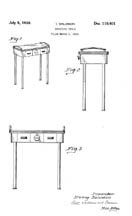
Design Patent D-110,401 for the Mode Craft Manicurist Table
Click to enlarge..
The August issue of Washingtonian Magazine (page 119) shows a picture of a large beauty salon in the 1940s and (mirable dictu) there is an identical Modecraft manicurist table...
Here are some other photos of Modecraft (also spelled "Mode-Craft") salon furniture.
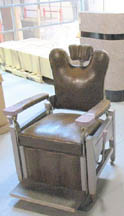 '
'
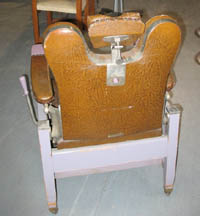
Barber Chair
Elvis had one of these and it sold for $18,000
Click to enlarge..
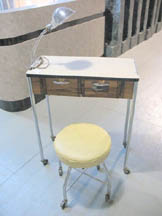
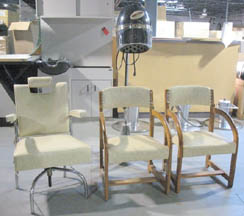
Manicurist Table and Chairs
That's a 1940s Helene Curtis Hair Dryer behind the chairs
Click to enlarge..
Recently, one of our readers sent us some photos of another Modecraft item, most likely a stylist's cabinet:
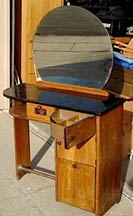 '
'
 '
'
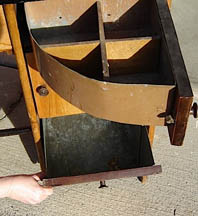
Modecraft Stylist Center
Click to enlarge..
Here is another ModeCraft manicurist table, complete with the revolving stool and chrome "gooseneck" lamp. My guess is that this is a bit later than the one I own.
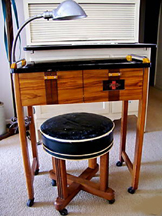
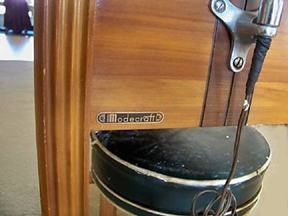 '
'
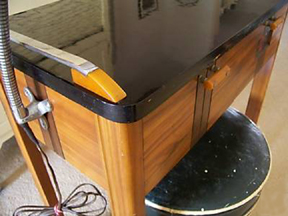
Modecraft Manicurist Table and Stool
Click to enlarge..
Our friend "Acme Ron" sent us this photo of his mother's beauty shop in Phoenix, taken in the mid 1940s. Click on the photo to see where the various individual pieces would have been located. Thanks, Ron!
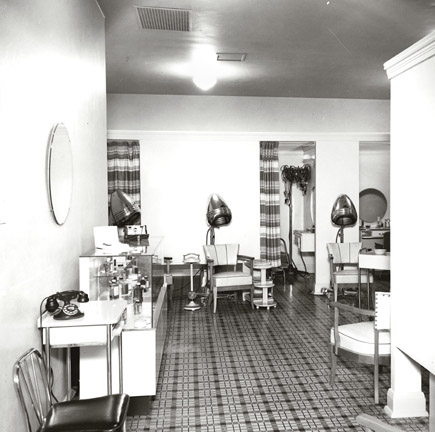
A Beauty Shop in the 1940s
Click to enlarge and see the position of various items..
Here is the Hair Stylist's Station, seen in the back right of the photo (enlarge it to see the station pointed out). Ron kept this and (aside from some dust) it seems to be in very good condition!
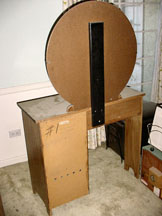 '
'
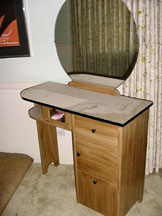
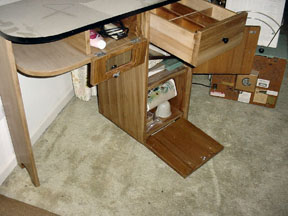 '
'
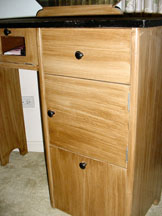
"Acme Ron"'s Stylist Center, Manufacturer Unknown
Click to enlarge..
Here are some photos of a Modecraft salon chair, most likely used by a lady sitting under a hair dryer. Thanks to "Acme Ron" once again for these photos.
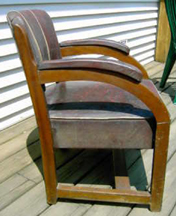
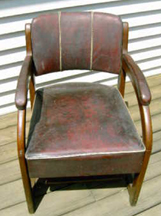
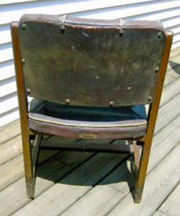
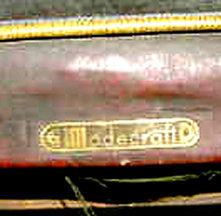

Modecraft Salon Chair (and Hair Dryer)
Click to enlarge..
Here are some patents by Hyman and Nellie Fidel, designers for the Modecraft Company. The items include a folding chair, a barber chair and a movable footrest.
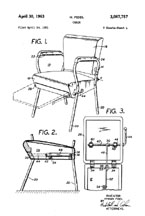 '
'
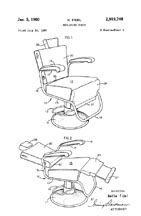 '
'
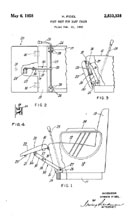
Patent Diagrams for Modecraft Designs by Hyman and Nellie Fidel
(l)H. Fidel No 3,087,757 (mid) N. Fidel No. 2,919,746 (r.) H. Fidel No. 2,833,338
Click to enlarge.
Click here to learn how to get your own FREE Patent Diagrams
Returning to my manicurist table: On the top of the table, some of the other treasures are displayed, including (clockwise): 1: The FDR campaign lamp discussed below; 2: an unusal statuette of a monkey holding a basketball, possibly a commentary on student athletes of the 1930s; 3: a "See, Hear, Speak No Evil" statuette in jadeite; 4: the paint sprayer attachement for the Electrolux; and 5: the Brannock Device, a tool for measuring foot sizes in a time when people wore shoes besides sneakers. The Electrolux Model XXX sleeps under the table like a faithful dog...
Click here to look at another type of collectible, or keep on scrolling for more Furniture.
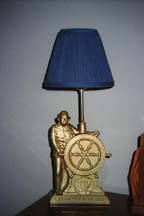
Lamp with FDR Steering the Ship of State
...a Great Little Piece of History!
Click to Enlarge
The lamp is very unusual. Made of pot metal, it depicts Franklin Roosevelt in storm gear steering the ship of state through troubled times. The inscription says "FDR Man of the Hour". Although the public knew that FDR was permanently confined to a wheelchair, they seemed to be perfectly willing to accept him in this heroic posture. We did a fairly close analysis and concluded that the piece had been brass plated. We did it one better -- we got a book of faux gold leaf and applied it to the lamp. We mixed up a batch of "sizing" --- full-strength varnish with red pigment. This was applied to the piece and allowed to tack up for an hour. The leaves (microscopically thin) are removed from a booklet with a camel brush. You rub the brush on a piece of wool to generate static electricity and you can grab the sheet out of the book. This is applied to the piece and patted down gently with a 1/2 inch artist's brush. The result is very striking. The red pigment on the sizing gives the gold leaf a nice rich color.
Click here to look at another type of collectible, or keep on scrolling for more Furniture.
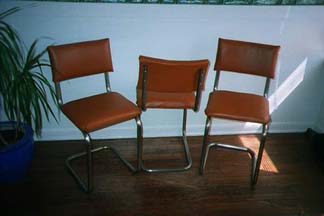
Douglas Kitchen Master Chairs
...Three for a Buck
Click to Enlarge
My partner and I ventured up to Chambersburg. I had warned her that the workshop was filled to overflowing and that we were NOT going to come back with any restoration projects. As we approached our very first thrift store, this resolve dissipated like a light fog. We didn't even have to go into the store. On the sidewalk in front of the store were three forlorn kitchen chairs tied together with string bearing a hand-lettered card that read "All three for $1".
My partner calls me the "patron saint of chairs" because I have this thing for restoring chairs. Usually, these things are junk, but I made a cursory examination and found that we had struck gold. But first some background.
In the 1920s, Marcel Breuer made history. He had a philosophy of reducing things to their bare minimum. As part of this, he created an art object --- the bare essence of "chair".
He started with electrical conduit, essentially a thin tubing that can be bent in any direction. He formed a three dimensional "S" shape and fashioned a seat and back out of a peach crate. Although it was done as an intellectual exercise, the darn thing was very comfortable. Thus, Breuer had unwittingly invented the Kitchen Chair of the 1950s. One of his original chairs is in the Baltimore Museum of Art and is worth a zillion dollars
No, the three forlorn chairs are NOT Breuer chairs. They are, however Douglas Kitchen Master chairs. My father was in the kitchen business for years and for many of those, I was dragged along, so I have intimate knowledge of kitchens of the 1950s. Dad always specified Douglas Kitchen Master chairs because they were made with real chrome tubing --- they would not rust, dent, or in any other way deteriorate. And, when I did some cursory rubbing onthe forlorn chairs in Chambersburg, layers of dirt, paint and grease came off easily to reveal the chrome below.
The Douglas "Kitchen-Master" chairs were immortalized by Norman Rockwell in his October 30, 1948 cover for The Saturday Evening Post, as shown below
The October 30, 1948 cover of The Saturday Evening Post
Click Here to read about the Sunbeam T-9 Toaster
Click Here to read about the Silex Vacuum Coffee maker
The next part of the saga moves to TEDCO, an upholstery supply store in Baltimore. This place is an upholsterer's dream --- not only do they stock everything at bargain prices, but they also have Specials. The day we visited them, they were having a special on REAL LEATHER seconds at $5 a yard. This is like getting steak at 10 cents a pound. Since we were upholstering kitchen chairs, it didn't really matter if a hide had holes in it or splotches, because we didn't need very big pieces. They also had a nice special on high quality foam, so we walked out with enough material to do the job for $17
Although leather is very hard to work with, the results more than justify our $1 investment!
Click here to look at another type of collectible, or keep on scrolling for more Furniture.
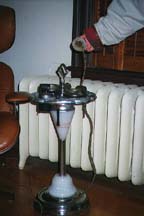
Art Metal Smoking Stand
...with the Cigar Lighter
Click to Enlarge
First of all, let us say that we are more-or-less devoted to preserving the 1940s and we DO NOT ADVOCATE SMOKING. This item is definitely not Politically Correct today, although something like this was a fixture in almost every American household during the 1940s. Alas, it has no use except as a smoking stand. We certainly understand that some of our readers may be concerned, but we got this as a sociological curiosity.
The base is made of stainless steel with unusual globes of opalescent milk glass. The top is cast aluminum and is decorated with Western themes -- a six-gun, a covered wagon, a stage coach and horses. The accessories include two ash trays, a cigarette holder, and a cigar/cigarette lighter. There are receptacles to hold four pipes, as shown. The base is lighted and emits a soft glow when all the lights are out except for the smoking stand and the dial of the radio. Just the scene for listening to the Lone Ranger on a winter night.
This is precisely the type of object that sat beside Dad's Chair, from which Paternal dictates (as in "You'll have to ask Dad about that") were interspersed with reading the paper. In my family, the Smoking Stand is an icon of patriarchy and probably was so in many other families of my generation. Political correctness aside, we felt that such an item was essential to our 1940s restoration.
However, the most distinctive part of this stand is the cigar/cigarette lighter. My partner's hand is holding it up in the photo. This is a milk glass piece that contains a nichrome wire resistance unit, much like the element in a toaster. A clever gravity switch that has a steel ball bearing keeps the lighter "off" when it rests in the stand. When you pick it up and tilt it toward your cigarette or cigar, the steel bearing rolls backwards, completes a circuit and the element glows red- hot. Believe me, this is a DANGEROUS item. The complete lighter assembly is a real rarity because when children came into the house, the first thing that went was the cigarette lighter. I can remember that the thing used to fascinate me when I was a kid. Then it disappeared. Even my Father's Absolute Power could not stand up to my Mother's hatred of the Cigarette Lighter. Don't ever mess with Mom...
We got this letter from our reader David:
"... I have a smoking stand almost identical to the one pictured on your page. The lighter on mine however went the way of my older brothers and or sisters, as you mentioned in your article. This was purchased for my grandfather for his 50th birthday in 1953. I need to rebuild the guts in the lighter. I was wondering if you could take a look at your cigarette lighter and describe to me what all is in the guts, I suspect it was a coil like you would find on a old space heater. If you have a digital camera, a photo would be great. If not please don't bother. Any help you could give would be greatly appreciated..."
As promised, here is a photo of the "insides" of the cigarette lighter:
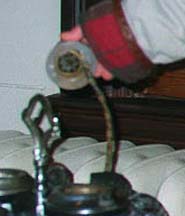
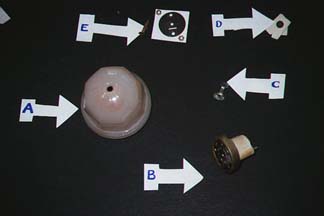
Components of the Cigar Lighter
The inner workings explained...
Click to Enlarge the Diagram
Key:
A: Glass Housing
B: Ceramic Element
C: Ball Cap
D. The Steel Shot
E. Screws, nuts, and fiber washer
The ceramic element (Part B) can also be disassembled, but the parts are too small for the resolution of my camera. Here is how the Lighter is put together:
- The metal Grille is press fit onto the molded ceramic core; it can be removed by bending out three strategically placed "dimples"
- The ceramic core has a spiral groove cast into it
- At the center of the ceramic core is a hole which leads into the shaft; A bolt goes through this holder and holds a brass cup (not shown). A nichrome wire spring is attached to the head of the bolt.
- The nichrome wire spring winds around the spiral groove where it is attached to a bolt that runs through the ceramic core (you can see the end of the bolt protruding through the core in the picture.) This is the "live" bolt.
- A "dummy" bolt goes through the other side of the ceramic core.
- The Steel shot [Part D] is inserted in the cup. The cap [Part C] is placed on top of the cup and is mounted on the "dummy" bolt.
- The fiber washer is placed atop the ceramic core. The slot points to the "dummy".
- The insulation is stripped from the cloth covered wire. "Eyes" are soldered to the wire.
- The "High" side is connected to the "live" bolt; the "Low" side is connected to the "dummy" bolt.
- The two nuts are used to secure the wire "eyes" to the bolts.
- The completed apparatus is inserted in the glass holder [Part A]. A miniature screwdriver is inserted in the hole at the top and is used to align the hole in the fiber washer with the center.
- The long screw secures the fiber washer (and the whole assembly) to the glass enclosure. There is a channel molded in the enclosure to receive the wire. (The wire sticks out the bottom of the lighter --- not through the top.)
- For safety sake, I wired the lighter cord so that the light in the base has to be switched to the "on" position for it to be hot.
Assembly is made a whole lot easier if you have nut drivers. All bolts and nuts are standard sizes. You can buy a nichrome wire coil at an appliance repair store. The ceramic element and glass enclosure are unique to the piece. I got the right insulated wire by cutting the cord off an old waffle iron.
PLEASE! Don't restore one of these if you have children in the house!
Here is a smoking stand with definite Art Deco Lines. It has no markings, but it certainly sets the mood of the Swing Era.
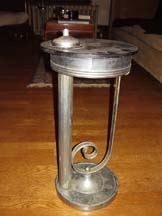
Art Deco Smoking Stand
Click to enlarge..
Here are two more smoking stands that were cultural icons during the 1930s through the 1950s. Basically, they started out as art objects and eventually wound up in seedy waiting rooms and lobbies. Those of you who got on the bus in the 1960s will probably think that they are the ugliest things to be placed on Earth. I invite you to take another look at these objects in the context of their original design patents. First off, we have a beautiful object designed by Karl Kipp, who was very famous as the head of Metalwork for the Roycroft commune before World War I. By 1938, he was working for the Daystream Company, for whom he designed the following:
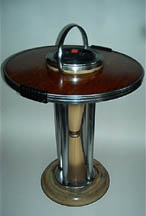
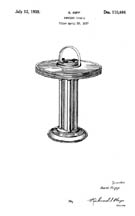
The Karl Kipp Smoking Stand -- Design Patent D-110,464
Click to enlarge..
The next smoking stand is almost invisible because it was found everywhere -- particularly in crowded waiting rooms and seedy hotel lobbies. It was designed by Onni Mankki, a Finnish designer/architect who settled in Cleveland Ohio.
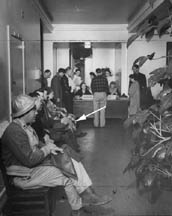
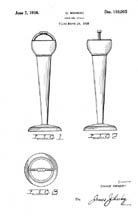
The Onni Mankki Smoking Stand -- Design Patent D-110,005
Click to enlarge..
Click here to look at another type of collectible, or keep on scrolling for more Furniture.
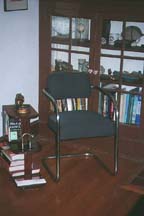
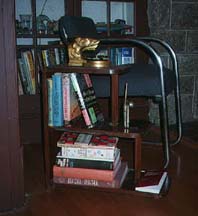
The Tubular Chair
The $1 Bargain
This set of photos illustrates the things that you can do with stuff that other people throw away.
Sunday September 20, 1998
My partner and I attended a rummage sale at a church in Chevy Chase. I found a tubular steel Art Deco chair sitting off in the corner --- it had a $1.00 price tag on it, but it was in unusually bad condition. Someone had re-upholstered it in very bad "nausea Green" Naugahyde. (NO Nauga should perish for this horrible color...) On the other hand, the chrome steel tubes of the chair form the outline of a perfect cube. I peered beneath the dust cover and noticed an oak frame with springs that had been attached by hand sewing. This detail and the aesthetics placed the piece in the late 1920s, early 1930s, so I took the fateful step and got out a dollar. One of our readers suggested that it may have been the work of designer Gilbert Rohde. It certainly has a lot of style.
On Monday, I found myself knee deep in problems with the Art Deco chair. It seems that someone had left the chair out in the rain a lot! On the positive side, the padding was real horsehair and cotton batting. On the negative side, only forensic pathologists can appreciate dealing with rotting horsehair and cotton batting. When I got the ugly naugahyde cover off and disposed of the padding, I found that the burlap had degenerated and there was considerable rot in the frame --- particularly in the sculptured back which seemed to be made out of a zillion pieces of laminated wood. So, I put away my upholsterer's tools and took up my carpenters tools. Alas, most of the rot was concentrated in the edges of the frame --- the same places that need to be very sound to accept the tacks and staples that hold the padding and fabric. It was fortunate that our pile of scraps from old furniture repair had enough wood to reconstruct the frame. The downside was that this took a whole bunch of time...
On Tuesday, working with a newly reconstructed frame, I had to re-set the springs, a process that is singularly difficult and about as exciting as watching paint dry. Not only is it physically arduous and boring but there is hardly any room for error. The springs have to be tied six ways and then burlap must be stiched over them. So far, I had invested only about eight hours of work in my dollar chair...
On Wednesday, We trip to the Fabric Store. We spent about an hour peering through the remnants bin. At the bottom of the pile, we found the perfect fabric --- it looked great and it had a regular small pattern that would be easy to match. Fabric and thread came to $25. Next, we went to an Upholstery shop. I had decided to replace the horsehair with three inch high density non-degradable foam; prices for this stuff are sky high --- enough foam and dacron batting for the job came to about $30.
The cushion requires welting between the seams, so that means sewing through four layers of cloth. My sewing machine would not handle the thickness, so we had to sew all the cushions by hand, something that kept us busy for another four hours. Pulling, tacking and stapling consumed another two hours.
By the time that we proudly placed the chair in the living room, we had invested about fourteen hours and about $60 in our dollar chair. Some things only look like bargains.
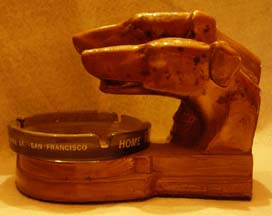
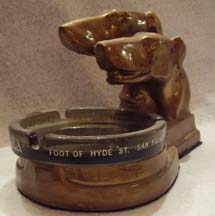
FrankArt Racing Greyhounds Ash Tray
Click to Enlarge
The photo also shows some of our other treasures. On the little bookshelf is a FrankArt Ashtray featuring two racing greyhounds, and a bookend called "Scaredy Cat" from the 1946 Chase Art Metal catalogue (shown in detail on our Knicknacks Page. We just acquired a bakelite cigarette box that operates in the same fashion as the martini bar.
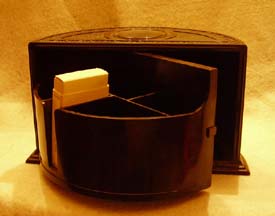
Bakelite Cigarette Box
Click to Enlarge
Click here to look at another type of collectible, or keep on scrolling for more Furniture.
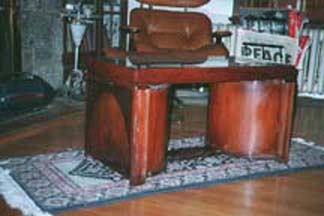
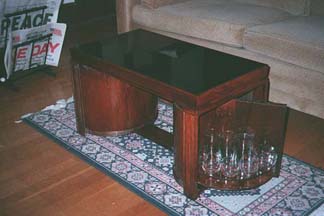
The Martini Bar
Another find..
Bulk Trash Day is a big event in our house. We hit the jackpot in this little Art Deco Martini Bar. Someone had tossed the thing out, possibly because it had broken in two and had no mirror top...
With considerable effort, we were able to repair and refinish the Bar. We are indebted to the folks at Read Plastics in Rockville who custom cut a piece of 1/2inch black lucite to make our table top.
In the background, you can see some of our other "found" treasures, including a streamlined vacuum cleaner, a western-theme lighted floor ashtray, an Eames Chair (YES! Someone in Chevy Chase actually tossed out a REAL Eames chair AND the ottoman!), and part of our collection of vintage newspapers.
The beautifully veneered ends swing open to reveal the glassware and equipment necessary to make the perfect Martini. The only fly in this ointment is that we don't drink... But, we have a souvenir from the period when the Martini was all the rage.
Click here to look at another type of collectible, or keep on scrolling for more Furniture.
Home | About Lindy | Last Week's Reviews | Upcoming Events | 1940s Collectibles
The Guide - Establishments - Travel - Accessories
Music | Links | Photo Gallery | Extras | Contact